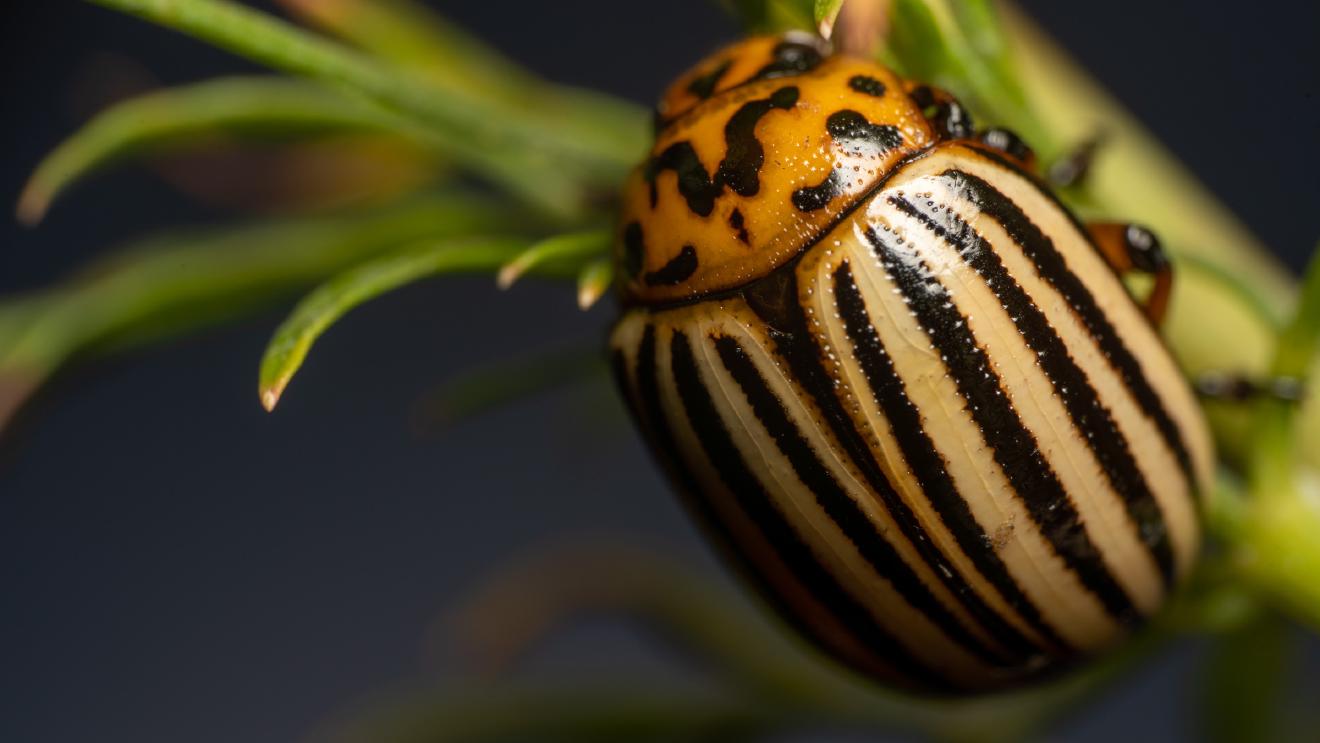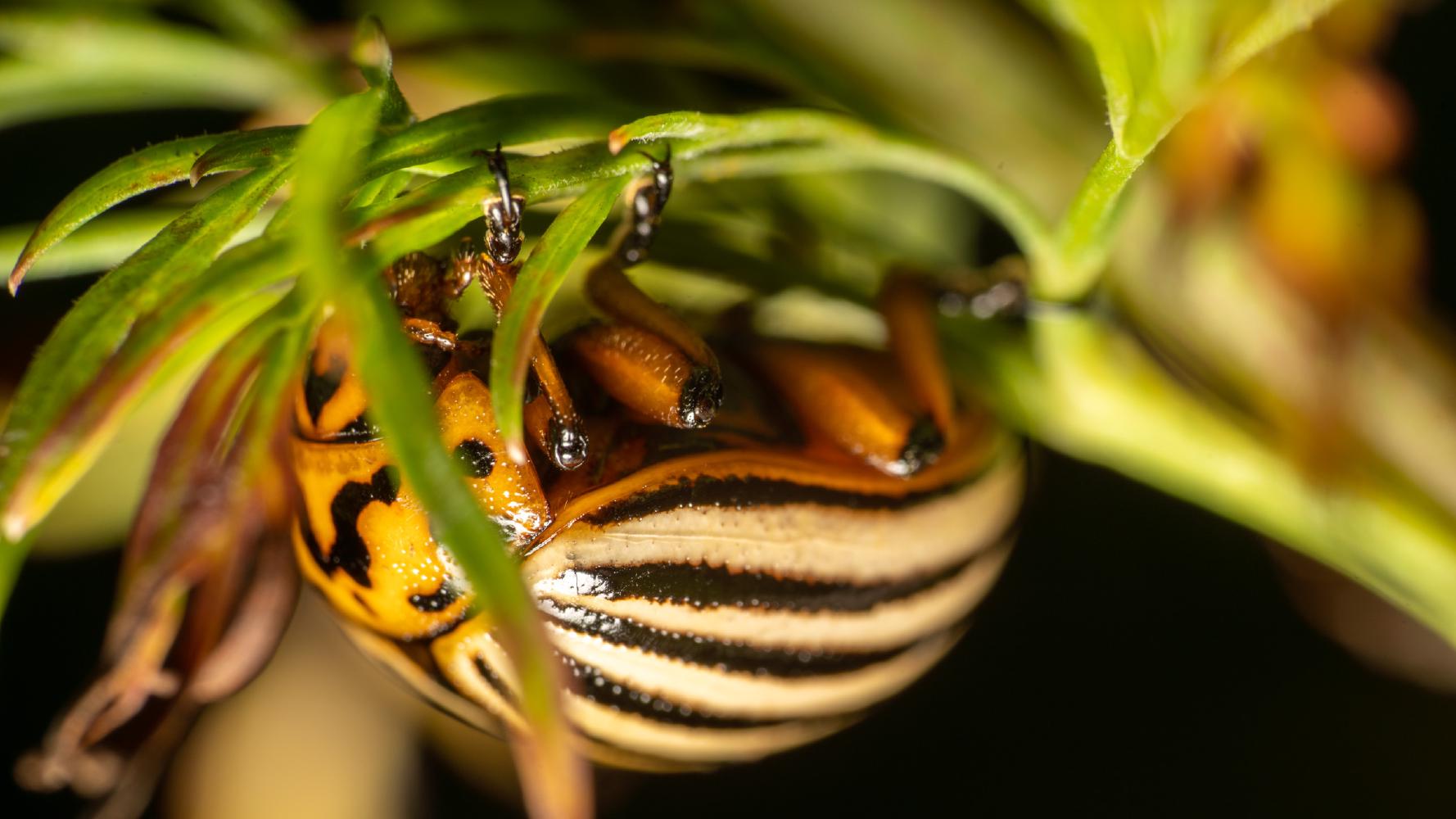Colorado Potato Beetle
Lat. “Leptinotarsa decemlineata“
species
of family
“Leaf Beetles“
1 species
The Colorado potato beetle was first observed in 1811 and was formally described in 1824. It is native to the area between Colorado and northern Mexico. The beetles are orange-yellow with black stripes and the larvae are orange-pink. The beetle is found in North America, Europe, and parts of Asia, and has the potential to spread to other regions. Females can lay over 500 eggs in a 4-5 week period and the beetles can go from egg to adult in as little as 21 days. Multiple generations can occur in a single growing season.
Taxonomy
The Colorado potato beetle was first observed in 1811 by Thomas Nuttall and was formally described in 1824 by American entomologist Thomas Say. The beetles were collected in the Rocky Mountains, where they were feeding on the buffalo bur, Solanum rostratum. The genus Leptinotarsa is assigned to the chrysomelid beetle tribe Chrysomelini (in subfamily Chrysomelinae).
Description
Adult beetles typically are 6–11 mm (0.24–0.43 in) in length and 3 mm (0.12 in) in width. They weigh 50-170 mg. The beetles are orange-yellow in colour with 10 characteristic black stripes on their elytra. The specific name decemlineata, meaning ’ten-lined’, derives from this feature. Adult beetles may, however, be visually confused with L. juncta, the false potato beetle, which is not an agricultural pest. L. juncta also has alternating black and white strips on its back, but one of the white strips in the center of each wing cover is missing and replaced by a light brown strip.The orange-pink larvae have a large, 9-segmented abdomen, black head, and prominent spiracles, and may measure up to 15 mm (0.59 in) in length in their final instar stage. The beetle larva has four instar stages. The head remains black throughout these stages, but the pronotum changes colour from black in first- and second-instar larvae to having an orange-brown edge in its third-instar. In fourth-instar larvae, about half the pronotum is coloured light brown. This tribe is characterised within the subfamily by round to oval-shaped convex bodies, which are usually brightly coloured, simple claws which separate at the base, open cavities behind the procoxae, and a variable apical segment of the maxillary palp.
Distribution
The beetle is most likely native to the area between Colorado and northern Mexico, and was discovered in 1824 by Thomas Say in the Rocky Mountains. It is found in North America, and is present in every state and province except Alaska, California, Hawaii, and Nevada. It now has a wide distribution across Europe and Asia, totalling over 16 million km2.Its first association with the potato plant (Solanum tuberosum) was not made until about 1859, when it began destroying potato crops in the region of Omaha, Nebraska. Its spread eastward was rapid, at an average distance of 140 km per year. By 1874 it had reached the Atlantic Coast. From 1871, American entomologist Charles Valentine Riley warned Europeans about the potential for an accidental infestation caused by the transportation of the beetle from America. From 1875, several Western European countries, including Germany, Belgium, France, and Switzerland, banned imports of American potatoes to avoid infestation by L. decemlineata.These controls proved ineffective, as the beetle soon reached Europe. In 1877, L. decemlineata reached the United Kingdom and was first recorded from Liverpool docks, but it did not become established. Many further outbreaks have occurred; the species has been eradicated in the UK at least 163 times. The last major outbreak was in 1976. It remains as a notifiable quarantine pest in the United Kingdom and is monitored by DEFRA to prevent it from becoming established. A cost-benefit analysis from 1981 suggested that the cost of the measures used to exclude L. decemlineata from the UK was less than the likely costs of control if it became established.Elsewhere in Europe, the beetle became established near USA military bases in Bordeaux during or immediately following World War I and had proceeded to spread by the beginning of World War II to Belgium, the Netherlands, and Spain. The population increased dramatically during and immediately following World War II and spread eastward, and the beetle is now found over much of the continent. After World War II, in the Soviet occupation zone of Germany, almost half of all potato fields were infested by the beetle by 1950. In East Germany, they were known as Amikäfer (‘Yankee beetles’) following a governmental claim that the beetles were dropped by American planes. In the European Union, it remains a regulated (quarantine) pest for the Republic of Ireland, Balearic Islands, Cyprus, Malta, and southern parts of Sweden and Finland. It is not established in any of these member states, but occasional infestations can occur when, for example, wind blows adults from Russia to Finland.The beetle has the potential to spread to temperate areas of East Asia, India, South America, Africa, New Zealand, and Australia.
Lifecycle
Colorado potato beetle females are very prolific and are capable of laying over 500 eggs in a 4- to 5-week period. The eggs are yellow to orange, and are about 1 mm (0.039 in) long. They are usually deposited in batches of about 30 on the underside of host leaves. Development of all life stages depends on temperature. After 4–15 days, the eggs hatch into reddish-brown larvae with humped backs and two rows of dark brown spots, one row on each side. They feed on the leaves of their host plants. Larvae progress through four distinct growth stages (instars). First instars measure about 1.50 mm (0.059 in) long, and the last (fourth) instars about 8 mm (0.31 in) long. The first through third instars each last about 2–3 days; the fourth lasts 4–7 days. Upon reaching full size, each fourth instar spends several days as a nonfeeding prepupa, which can be recognized by its inactivity and lighter coloration. The prepupae drop to the soil and burrow to a depth of several inches, then pupate. In 5 to 10 days, the adult beetle emerges to feed and mate. This beetle can thus go from egg to adult in as little as 21 days. Depending on temperature, light conditions, and host quality, the adults may enter diapause and delay emergence until spring. They then return to their host plants to mate and feed; overwintering adults may begin mating within 24 hours of spring emergence. In some locations, three or more generations may occur each growing season.
Notes
1.^ For a more comprehensive list of natural predators, pathogens and parasitoids, see here.
External links
PotatoBeetle.org Polish Film Chronicle: Fight against Colorado Beetle (in Polish)


Ancestry Graph
Further Information
Copyright

This article uses material from the Wikipedia article Leptinotarsa decemlineata the free encyclopedia Wikipedia which is released under Creative Commons Attribution-ShareAlike 4.0 International License). On Wikipedia a list of authors is available.
